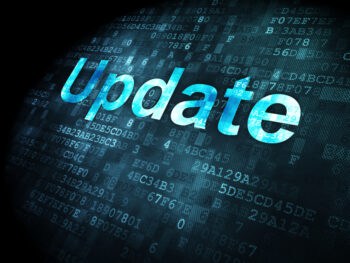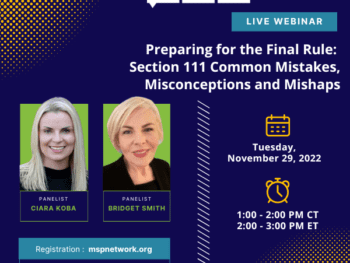In addition to the recent publication of the Non-Group Health Plans (NGHP) User Guide on 3/16/09, Center for Medicare & Medicaid Services (CMS) recently released an Alert intended to answer a few open issues remaining from the User Guide. The Alert was published on March 23, 2009. Contained within the Alert are a few key updates: Extended Testing Periods CMS has extended the testing period an additional three months. Testing will now occur between 7/1/09 and 12/31/09, shifting the requirement for live-data reporting to Q1 2010. This is substantial from a preparation standpoint, but should not give anyone the mistaken hope that it is time to slow down. Registration is a lengthy multi-step process still scheduled between 5/1/09 and 6/30/09 (just 36 days away). Registration is expected to include tens of thousands of Responsible Reporting Entities (RREs). After registration, each RREs Reporting Agent must conduct a series of data tests with the Coordination of Benefits Center (COBC) before the first Medicare Query Function (MQF) file can be submitted. Imagine how long this testing might take CMS to complete with +50,000 RREs registering at the same time. After successful completion of the testing, an MQF file must be loaded to CMS to determine Medicare beneficiary status on the RRE's claims. It takes CMS 14 days to respond to the MQF file. The MQF response file from CMS will tell us which claims need to be reported in the first Mandatory Insurer Reporting (MIR) input file as early as January 2010. All of these cases involving Medicare (workersxzcompxzkit) beneficiaries must be updated to include CMS' new required data. This is a large endeavor for an Insurer/TPA/self-insurer, requiring a great deal of time pre-live reporting. As an example, if you have 500,000 open claims and 8% of them involve a Medicare beneficiary, then 40,000 claims need to be updated to meet CMS reporting requirements. If your system is robust and captures 100 of the 180 CMS fields, there are still up to 80 fields per claim to enter, or roughly 3.2 million individual items for data entry. Bottom-line: The extended testing period just gives us more time to get our files in order for the 1st live report in Q1 2010. Don't relax yet.Interim Reporting Thresholds CMS has also offered some much wanted low dollar thresholds for settlements, judgments, and awards Settlement/Judgment/Award (S/J/A) in workers' compensation (WC) and liability, meaning these cases do not need to be reported at the time of S/J/A. What is interesting about the thresholds is that they reduce over time. Here is the summary of these thresholds and their effective dates: TPOC* Date between 7/1/09 and 12/31/10 and TPOC Amount less than or equal to $5000.00 – Not Reportable
- TPOC Date between 1/1/11 and 12/31/11 and TPOC Amount less than or equal to $2000.00 – Not Reportable
- TPOC Date between 1/1/12 and 12/31/12 and TPOC Amount less than or equal to $600.00 – Not Reportable *TPOC: Total Payment Obligation of Claimant.
After 1/1/13, all TPOC Amounts will be reportable. CMS reiterates that these are not "safe harbors" and that their MSP rights apply regardless of whether or not the S/J/A is reportable through MIR. They reserve the right to change these thresholds in the future. Multiple TPOC Amounts must be summed to determine if the threshold was breached, no cheating by breaking the settlements into 47 individual settlements allowed. Another threshold they discussed is only applicable to Workers' Compensation cases with ORM (Ongoing Responsibility for Medicals) through 12/31/10. It appears to have been developed to focus on medical only claims with little to no loss time and limited medical payments. The rules for this exception are clearly articulated in the attached document. There is no threshold for liability or no-fault cases with ORM. Bottom-line: These thresholds take away reporting responsibility on a lot of nuisance value settlements and claims in the short term, but eventually everything will be reported. Conclusion There were also a few technical notes and updates that are ultimately not relevant unless you are a Reporting Agent in the Alert. Both the testing extension and interim reporting thresholds were much desired requests from the industry. CMS has delivered on both in the short term, but ultimately we will be reporting all the data CMS needs to enforce its Secondary Payer Rights in workers compensation, liability and no-fault. Many thanks to Gould & Lamb, LLC for providing this article. Click on these links to try our calculators and WC 101. WC Calculator www.ReduceYourWorkersComp.com/calculator.php TD Calculator www.ReduceYourWorkersComp.com/transitional-duty-cost-calculator.php WC 101 www.ReduceYourWorkersComp.com/workers_comp.php Do not use this information without independent verification. All state laws are different. Consult with your corporate legal counsel before implementing any cost containment programs. ©2008 Amaxx Risk Solutions, Inc. All rights reserved under International Copyright Law. If you would like permission to reprint this material, contact Info@WorkersCompKit.com












